tire pressure AUDI RS7 SPORTBACK 2015 Owners Manual
[x] Cancel search | Manufacturer: AUDI, Model Year: 2015, Model line: RS7 SPORTBACK, Model: AUDI RS7 SPORTBACK 2015Pages: 302, PDF Size: 74.76 MB
Page 5 of 302
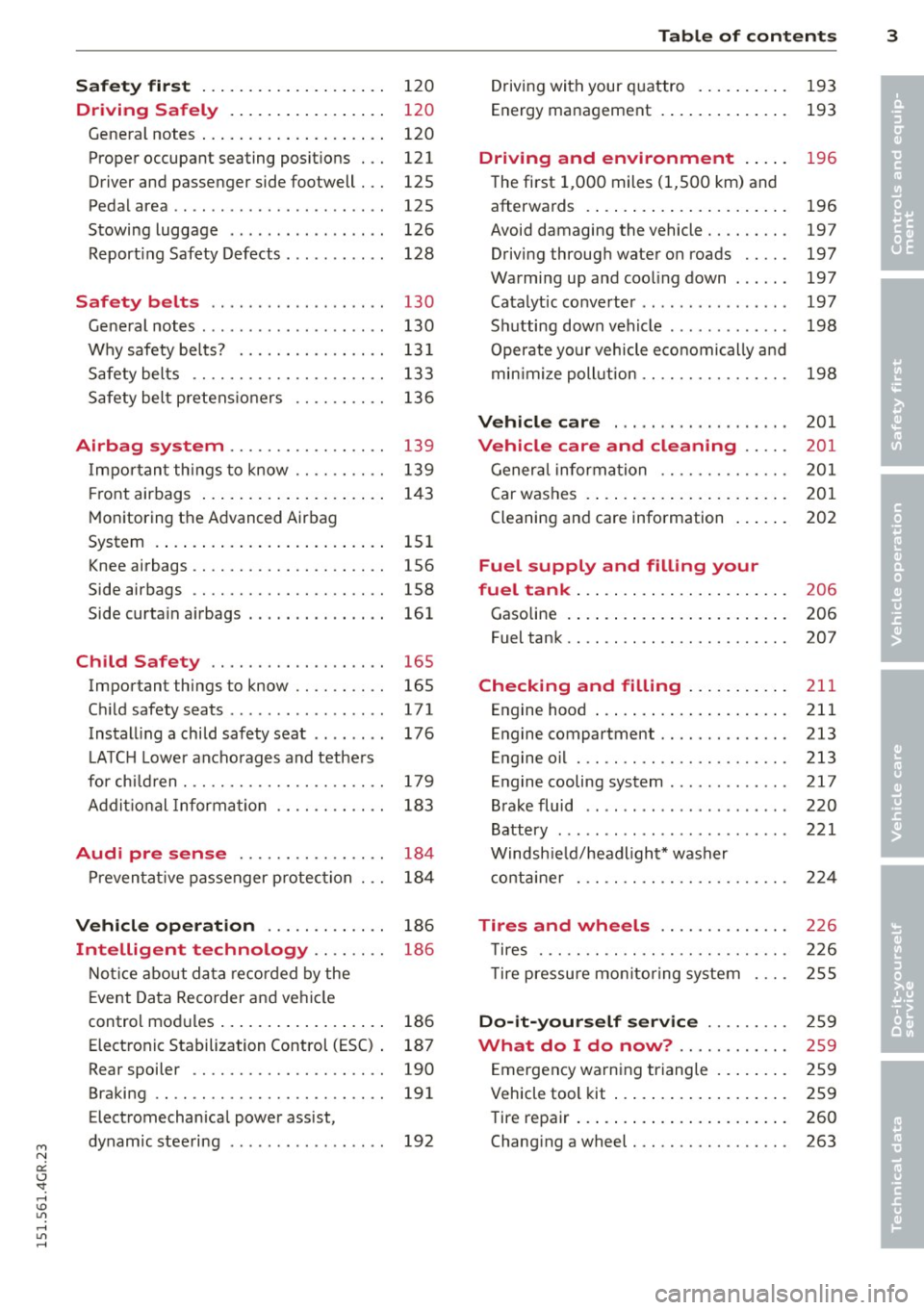
M N
0:: <.J 'SI: ,...., \!) ..,.,
,...., ..,., ,....,
Safet y fir st . . . . . . . . . . . . . . . . . . . . 120
Driving Safely . . . . . . . . . . . . . . . . . 120
General notes . . . . . . . . . . . . . . . . . . . . 120
Proper occupant seating posit ions . . . 121
Driver and passenger side footwell . . . 125
Pedal area . . . . . . . . . . . . . . . . . . . . . . . 125
Stowing luggage . . . . . . . . . . . . . . . . . 126
R eport ing Safety Defects . . . . . . . . . . . 128
Safety belts . . . . . . . . . . . . . . . . . . . 130
General notes . . . . . . . . . . . . . . . . . . . . 130
Why safety bel ts? .. .. .. .. .. . . .. . . 13 1
Safety belts . . . . . . . . . . . . . . . . . . . . . 133
Safety belt p re tens ioners . . . . . . . . . . 136
Airbag system . . . . . . . . . . . . . . . . . 139
I mpor tan t th ings to know . . . . . . . . . . 139
Fr ont airbags . . . . . . . . . . . . . . . . . . . . 14 3
M onitoring the Advanced Airbag
System . . . . . . . . . . . . . . . . . . . . . . . . . 151
Knee airbags . . . . . . . . . . . . . . . . . . . . . 156
Side airbags . . . . . . . . . . . . . . . . . . . . . 158
Side curta in a irbags . . . . . . . . . . . . . . . 161
Ch ild Safety . . . . . . . . . . . . . . . . . . . 165
Important things to know .. .. .. .. . .
C hi ld safety seats ............ .... .
Install ing a chi ld safety seat .. .. ... .
L A TC H L ower ancho rages and tethe rs
fo r ch ild ren . ............. .... .. . .
A ddit io nal Informa tion
Audi pre sense .......... .. .. . .
Pr even ta ti ve passe nger p rotec tion
Vehicle operation ....... .. .. . .
Intelligent technology .. .. .. . .
N ot ice about da ta re corded by the
E vent Data Recorder and vehi cle 165
171
176
179
183
184
18 4
186
186
control mo dules . . . . . . . . . . . . . . . . . . 186
Elect ronic Stabilization Control (ESC) . 187
Rear spoiler . . . . . . . . . . . . . . . . . . . . . 190
Braking . . . . . . . . . . . . . . . . . . . . . . . . . 191
Elect romechan ical power assist,
dynam ic steering . . . . . . . . . . . . . . . . . 192
Table of contents 3
Driving with your q uattro . . . . . . . . . . 193
Energy management . . . . . . . . . . . . . . 193
Driving and environment . . . . . 196
T he first 1,000 miles (1 ,500 km) and
afterwards . . . . . . . . . . . . . . . . . . . . . . 196
Avoid damaging the vehicle . . . . . . . . . 197
Driving throug h water on roads . . . . . 197
Warmi ng up and coo ling down . . . . . . 197
Catalytic co nverter . . . . . . . . . . . . . . . . 197
Sh utting down vehicle . . . . . . . . . . . . . 198
Operate your vehicle economically a nd
min imi ze poll ution . . . . . . . . . . . . . . . . 198
Vehicle care . . . . . . . . . . . . . . . . . . . 201
Vehicle care and cleaning . . . . . 201
Gener al infor mation . . . . . . . . . . . . . . 201
Car washes . . . . . . . . . . . . . . . . . . . . . . 201
Cleaning and care information . . . . . . 202
Fuel supply and filling your
fuel tank . . . . . . . . . . . . . . . . . . . . . . .
206
Gasoline . . . . . . . . . . . . . . . . . . . . . . . . 206
Fuel tank. . . . . . . . . . . . . . . . . . . . . . . . 207
Checking and filling . . . . . . . . . . . 211
Engine hood . . . . . . . . . . . . . . . . . . . . . 211
Engine compartment.............. 213
Engine oil . . . . . . . . . . . . . . . . . . . . . . . 213
Engine cooling system . . . . . . . . . . . . . 217
Brake fluid . . . . . . . . . . . . . . . . . . . . . . 220
Battery . . . . . . . . . . . . . . . . . . . . . . . . . 221
Windsh ie ld/headlight* washer
c ont ainer . . . . . . . . . . . . . . . . . . . . . . . 224
Tires and wheels . . . . . . . . . . . . . . 226
T ires . . . . . . . . . . . . . . . . . . . . . . . . . . . 226
T ire pressure mo nitor ing system 255
Do-it -yourself service . . . . . . . . . 2 59
What do I do now? . . . . . . . . . . . . 259
E mergency warn ing triangle . . . . . . . . 259
Vehicle tool kit . . . . . . . . . . . . . . . . . . . 259
T ire repa ir . . . . . . . . . . . . . . . . . . . . . . . 260
Changi ng a wheel . . . . . . . . . . . . . . . . . 263
•
•
Page 15 of 302

M N
0:: <.J 'SI: ,...., \!) 1.1'1 ,...., 1.1'1 ,....,
Instrument s and warnin g/indic ator ligh ts 13
Canada m odel s:
Anti-lock braking system (ABS)
defective ,/
¢ page 18
Worn brake pads ¢page 19
Electromechanical parking
brake
¢ page 15
Tire pressure monitoring sys tem./
¢ page 255
Tir e p ress ure monitoring sys
tem
¢ page 255
Electronic power control./
¢ page 19
Malfunction indicator Lamp
(MIL),/
¢page 20
Engine speed limitation
¢ page 20
Engine oil leve l
¢ page 17
Engine oil sensor
¢ page 20
Request to warm engine by
driving
¢ page 20
Battery
¢ page 16
Tank system
¢page 20
Windshield washer fluid leve l
¢ page 20
Windshield wipers ¢ page 21
Remote control key
¢ page 74
Remote control key
¢ page 76
Battery in remote control key
¢ page 32
/:
Defective light bulb warning
c:::> page 21
Rear fog light(s)
c:::> page 21
Headlight range control
c:::> page 21
adaptive light*
c:::> page 21
L ight-/ra in sensor fa ulty
c:::>page 21
Aud i active lane ass ist*
c:::> page 91
Adapt ive dampers*
c:::>page 21
Transm iss ion
c:::> page 107
Electronic steering column lock
c:::> page 17
Eng ine start system
c:::>page 17
Centra l ind icator light
c:::> page 18
E lectromechanica l steering, dy
namic steering* ,/
c:::> page 192
A ir suspension*
c:::> page 17
Sport d ifferent ial*
c:::> page 21
Rear spoiler
c:::> page 190
Other indicator light s
-------------
Turn signals
c:::> page22
USA model s: Cruise control *
c:::> page 79
Canada models: C ruise control*
c:::> page 79
Adapt ive cr uise control*
c:::> page 83
Adapt ive cr uise control*
c:::> page 83
Page 129 of 302
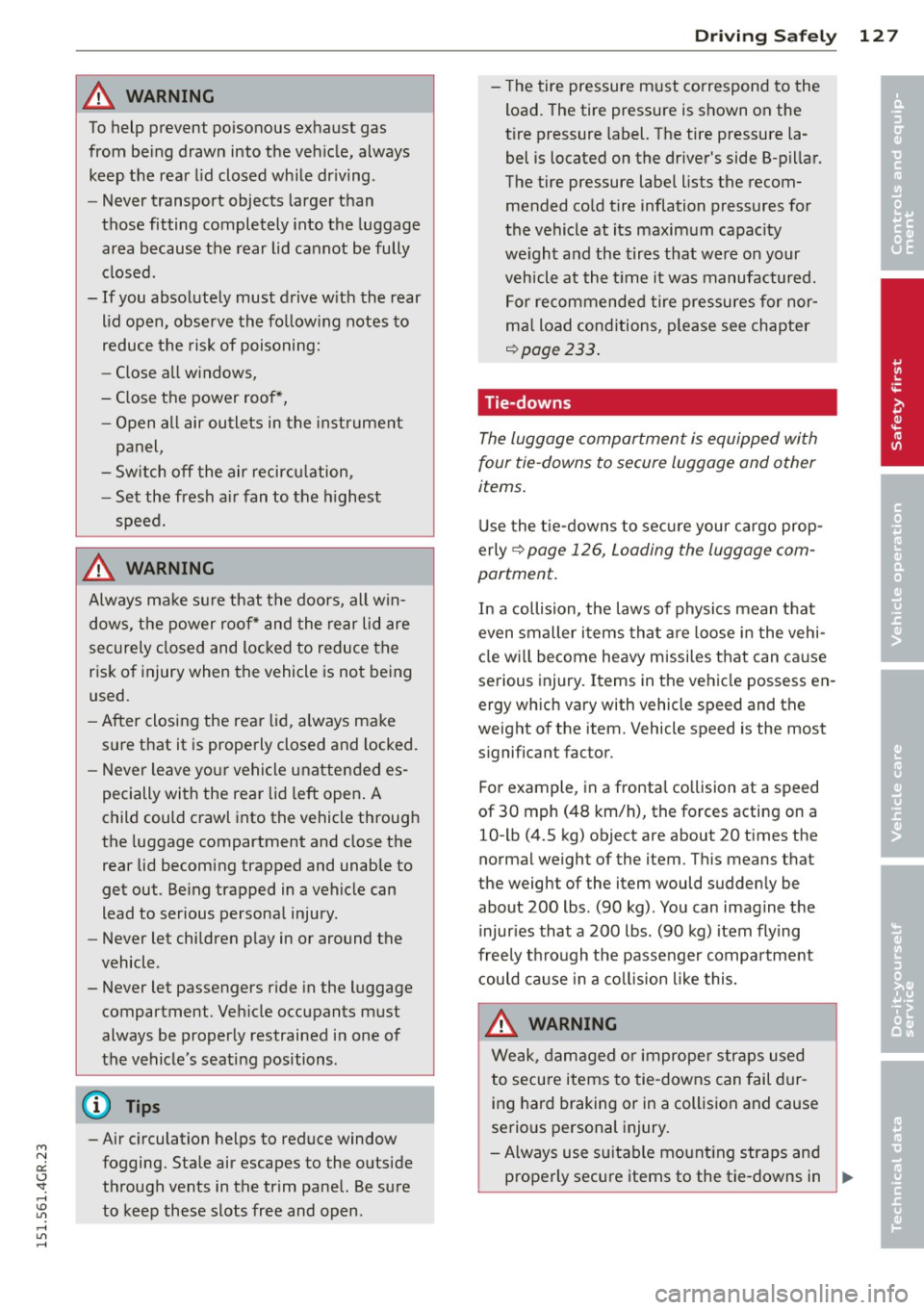
A WARNING ,~
To help prevent poisonous exhaust gas
from being drawn into the vehicle, always
keep the rear lid closed while driving .
- Never transport objects larger than
those fitting completely into the luggage
area because the rear lid cannot be fully
closed.
- If you absolutely must drive with the rear
lid open, observe the following notes to
reduce the risk of poisoning:
- Close all windows,
- Close the power roof*,
- Open all air outlets in the instrument
panel,
- Switch off the air recirculation,
- Set the fresh air fan to the highest
speed.
A WARNING
Always make sure that the doors, all win dows, the power roof* and the rear lid are
securely closed and locked to reduce the
risk of injury when the vehicle is not being
used.
- After closing the rear lid, always make
sure that it is properly closed and locked.
- Never leave your vehicle unattended es
pecially with the rear lid left open. A
child could crawl into the vehicle through
the luggage compartment and close the
rear lid becoming trapped and unable to
get out. Being trapped in a vehicle can
lead to serious personal injury.
- Never let children play in or around the
vehicle .
- Never let passengers ride in the luggage
compartment. Vehicle occupants must
always be properly restrained in one of
the vehicle's seating positions.
Gj) Tips
-Air circulation helps to reduce window fogging. Stale air escapes to the outside
through vents in the trim panel. Be sure
to keep these slots free and open .
-
Driving Safely 127
-The tire pressure must correspond to the
load. The tire pressure is shown on the
tire pressure label. The tire pressure la
bel is located on the driver's side B-pillar.
The tire pressure label lists the recom
mended cold tire inflation pressures for
the vehicle at its maximum capacity
weight and the tires that were on your
vehicle at the time it was manufactured. For recommended tire pressures for nor
mal load conditions, please see chapter
I:!) page 233.
Tie-downs
The luggage compartment is equipped with
four tie-downs to secure luggage and other
items.
Use the tie-downs to secure your cargo prop
erly<>
page 126, Loading the luggage com
partment.
In a collision, the laws of physics mean that
even smaller items that are loose in the vehi
cle will become heavy missiles that can cause
serious injury. Items in the vehicle possess en
ergy which vary with vehicle speed and the
weight of the item. Vehicle speed is the most
significant factor.
For example , in a frontal collision at a speed
of 30 mph (48 km/h), the forces acting on a 10-lb (4.5 kg) object are about 20 times the
normal weight of the item. This means that
the weight of the item would suddenly be about 200 lbs. (90 kg) . You can imagine the
injuries that a 200 lbs . (90 kg) item flying
freely through the passenger compartment
could cause in a collision like this.
A WARNING
Weak, damaged or improper straps used
to secure items to tie-downs can fail dur
ing hard braking or in a collision and cause
serious personal injury.
-Always use suitable mounting straps and properly secure items to the tie-downs in
'
•
•
Page 203 of 302

M N
0:: <.J 'SI: ,...., \!) ..,.,
,...., ..,., ,....,
Vehicle care and clean ing
General information
Regular, proper care helps to maintain your
vehicle 's value. It can also be a requirement
when submitting warranty claims for corro
sion damage and paint defects on the body .
The required cleaning and care products can
be obtained from your authorized Audi dealer
or a qualified workshop . Read and follow the
instructions for use on the packaging.
A WARNING
-Us ing clean ing and care products incor
rectly can be dangerous to your hea lth.
- Always store cleaning and care products
out of reach of children to reduce the risk
of poisoning.
@) For the sake of the environment
-Preferably use environmentally-friendly
products when buying cleaning agents.
- Do not d ispose of leftover cleaning and
care products with household trash .
Car washes
-
The longer that deposits such as insects, bird
droppings, tree sap or road salt remain on the
vehicle, the more the surface can be dam
aged. High temperatures such as those
caused by sunlight increase the corrosive ef
fect.
Before washing, wet heavy deposits w ith plen
ty of water.
Also, wash the underside of your vehicle once road salt stops be ing used for the season.
Pressure washers
When washing your vehicles with a pressure
washer, always follow the operating instruc
tions provided w ith the pressure washer . Th is
is especially important in regard to the pres
sure and spraying distance. Do not aim the
spray directly at seals on side w indows, doors,
Vehicle care and cleaning 201
the hood, the rear lid or the sunroof* or at
tires, rubber hoses, insulating material, sen sors* or camera lenses* . Keep a distance of at
least 16 inches (40 cm).
Do not remove snow and ice with a pressure
washer.
Never use rotary nozzles or high pressure noz
zles.
The water temperature must not be above
140 °F (60 °C) .
Automatic car washes
Spray off the vehicle before washing.
Make sure that the windows and roof* are
closed and the windshield wipers are
off. Fol
low instructions from the car wash operator,
especially if there are accessories attached to
your vehicle.
If possible, use car washes that do not have
brushes .
Only use car washes where the vehicle re
mains stat ionary and the wash ing equipment
moves around the vehicle when washing and
drying. Car washes that move the vehicle
through the car wash using a chain are not
recommended.
Washing by hand
Clean the vehic le starting from the top and
working down using a soft sponge or cleaning
brush. Use solvent-free cleaning products .
Washing vehicles with matte finish paint
by hand
To avoid damaging the paint when washing,
first remove dust and large particles from
your vehicle. Insects, grease spots and finger
pri nts are best removed w ith a special cleaner
for matte finish paint .
Apply the product using a microfiber cloth. To
avoid damaging the paint surface, do not use
too much pressure.
Rinse the vehicle thoroughly with water. Then
clean using a neutral shampoo and a soft mi-
crofiber cloth. ..,.
•
•
Page 231 of 302
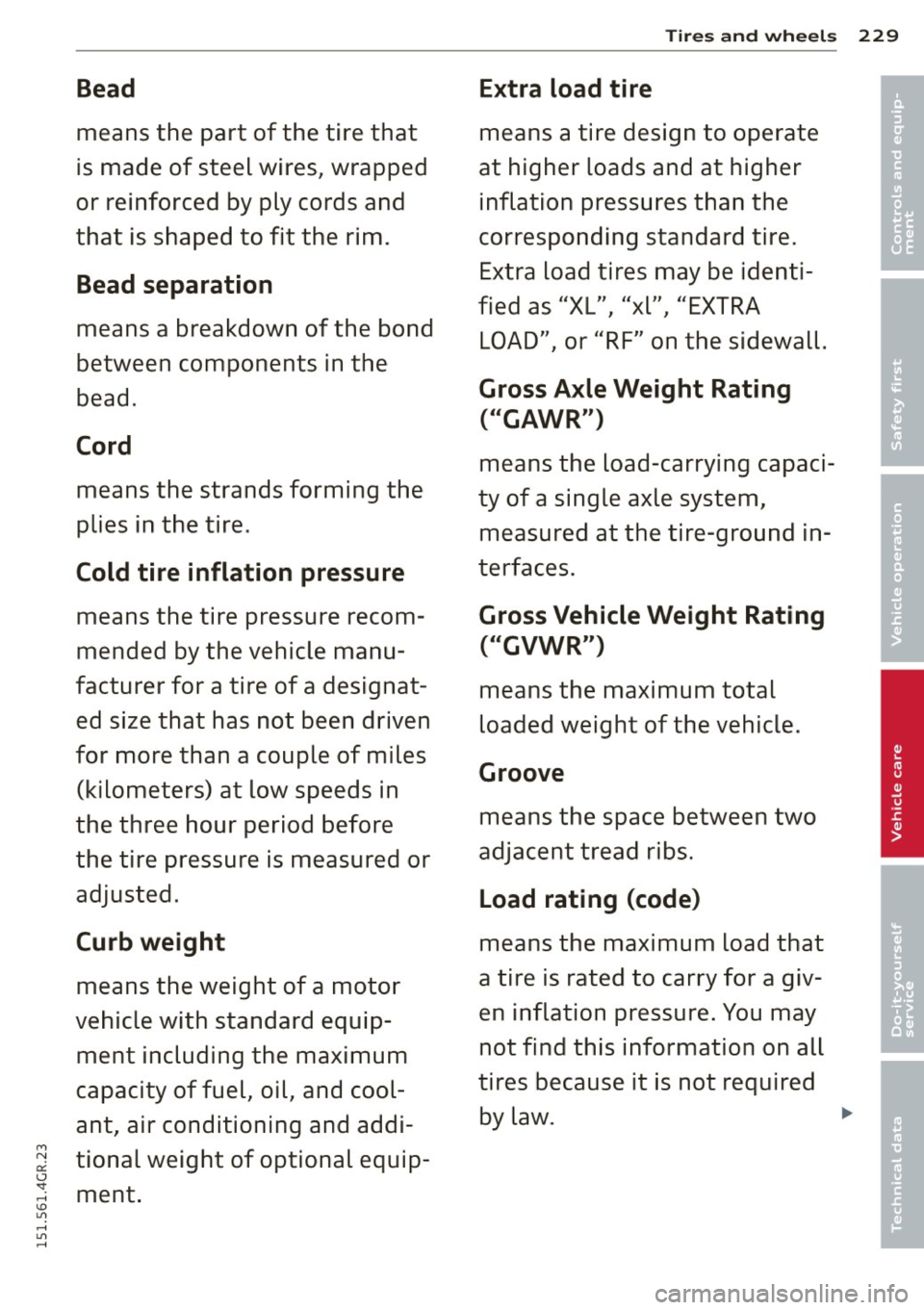
Bead
means the part of the tire that
is made of steel wires, wrapped
or reinforced by ply cords and
that is shaped to fit the rim .
Bead separation
means a breakdown of the bond
between components in the
bead.
Cord
means the strands forming the
plies in the tire.
Cold tire inflation pressure
means the tire pressure recom
mended by the vehicle manu
facturer for a tire of a designat
ed size that has not been driven
for more than a couple of miles (kilometers) at low speeds in
the three hour period before
the tire pressure is measured or
adjusted.
Curb weight
means the weight of a motor
vehicle with standard equip
ment including the maximum
capacity of fuel, oil, and cool
ant, air conditioning and addi
tional weight of optional equip
ment.
Tires and wheels 229
Extra load tire
means a tire design to operate
at higher loads and at higher inflation pressures than the
corresponding standard tire. Extra load tires may be identi
fied as "XL", "xl", "EXTRA
LOAD", or "RF" on the sidewall.
Gross Axle Weight Rating ("GAWR")
means the load-carrying capaci
ty of a single axle system,
measured at the tire-ground in
terfaces.
Gross Vehicle Weight Rating ("GVWR")
means the maximum total
loaded weight of the vehicle.
Groove
means the space between two
adjacent tread ribs.
Load rating (code)
means the maximum load that
a tire is rated to carry for a giv
en inflation pressure. You may
not find this information on all
tires because it is not required by law.
•
•
'
Page 232 of 302

230 Tires a nd whee ls
Ma ximum load rating
means the load rating for a tire
at the maximum permissible in
flation pressure for that tire.
Maximum loaded vehicle
weight
means the sum of:
(a) Curb weight
(b) Accessory weight
(c) Vehicle capacity weight, and
(d) Production options weight
Maximum (permissible)
inflation pressure
means the maximum cold infla
tion pressure to which a tire
may be inflated. Also called
"maximum inflation pressure."
Normal occupant weight
means 150 lbs. (68 k ilograms)
times the number of occupants seated in the vehicle up to the
total seat ing capac ity of your
vehicle.
Occupant distribution
means distribution of occu
pants in a vehicle .
Outer diameter
means the overall diameter of
an inflated new tire.
Overall width
means the linear distance be
tween the ex teriors of the side
walls of an inflated tire, includ
ing elevations due to labeling,
decorations, or protect ive
bands or ribs .
Ply
means a layer of rubber -coated
parallel cords .
Production options weight
means the comb ined we ight of
those installed regular produc
tion op tions weighing over 5
lbs . (2. 3 kg) in excess of those
standard items which they re
place, no t prev iously consid
ered in curb weight or accessory
weight , incl uding heavy duty
brakes, ride leve lers, roof rac k,
heavy duty bat tery, and spec ial
trim.
Radial ply tire
means a pneumatic tire in
wh ich the p ly c ords that extend
t o the beads are laid at sub
stantially 90 degrees to the
centerline of the t read .
Page 233 of 302
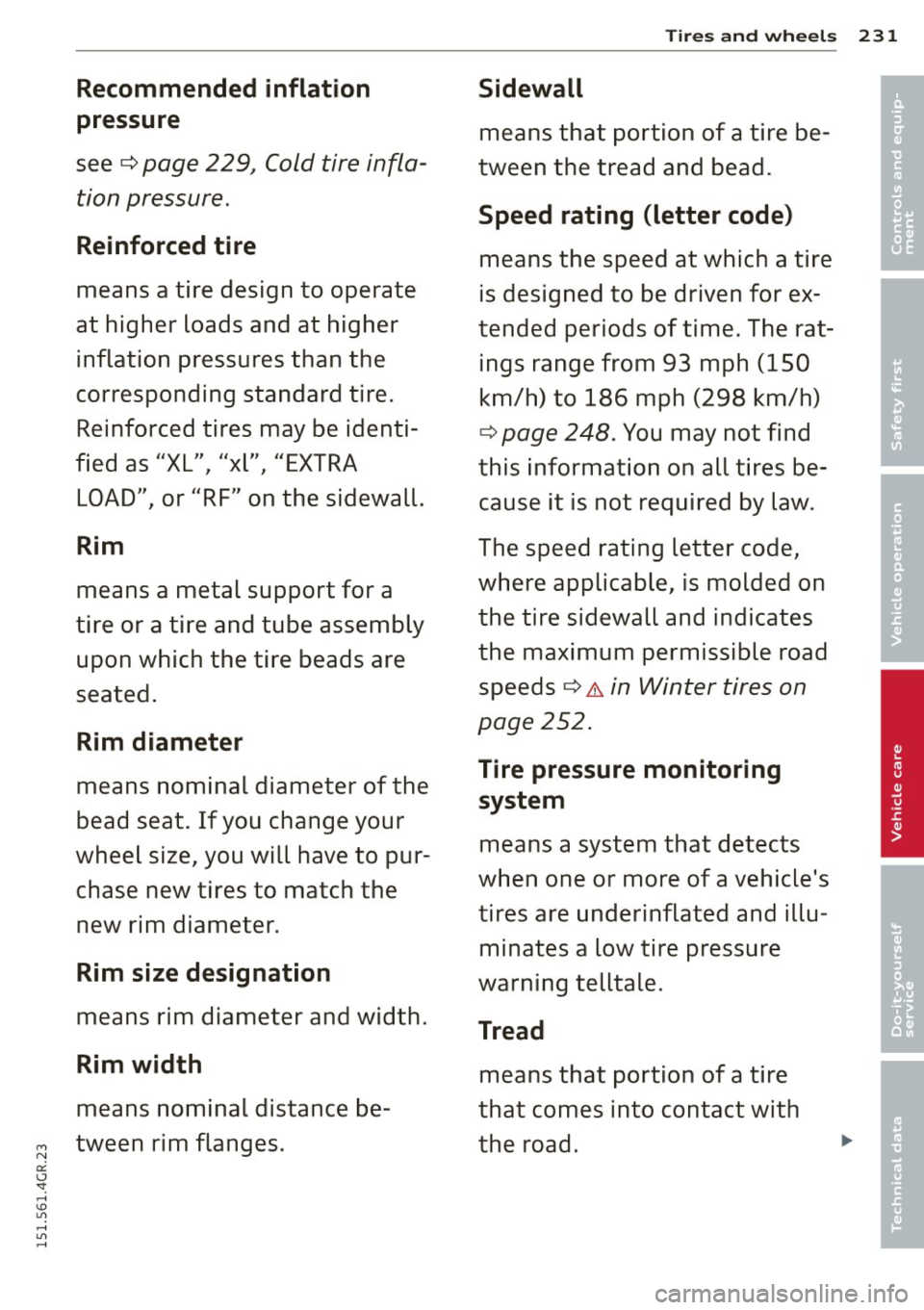
Recommended inflation
pressure
see¢ page 229J Cold tire infla
tion pressure.
Reinforced tire
means a tire design to operate
at higher loads and at higher
inflation pressures than the
corresponding standard tire. Reinforced tires may be identi
fied as "XL", "xl", "EXTRA
LOAD", or "RF" on the sidewall.
Rim
means a metal support for a
tire or a tire and tube assembly
upon which the tire beads are
seated.
Rim diameter
means nominal diameter of the
bead seat. If you change your
wheel size, you will have to pur chase new tires to match the
new rim diameter.
Rim size designation
means rim diameter and width.
Rim width
means nominal distance be
~ tween rim flanges.
0:: <.J 'SI: ,...., \!) 1.1'1 ,...., 1.1'1 ,....,
Tires and wheels 231
Sidewall
means that portion of a tire be
tween the tread and bead.
Speed rating (letter code)
means the speed at which a tire
is designed to be driven for ex
tended periods of time. The rat ings range from 93 mph (150
km/h) to 186 mph (298 km/h)
¢
page 248. You may not find
this information on all tires be cause it is not required by law.
The speed rating letter code,
where applicable, is molded on
the tire sidewall and indicates
the maximum permissible road speeds ¢
A in Winter tires on
page 252.
Tire pressure monitoring system
means a system that detects
when one or more of a vehicle's tires are underinflated and illu
minates a low tire pressure
warning telltale.
Tread
means that portion of a tire
that comes into contact with
the road.
•
•
'
Page 235 of 302
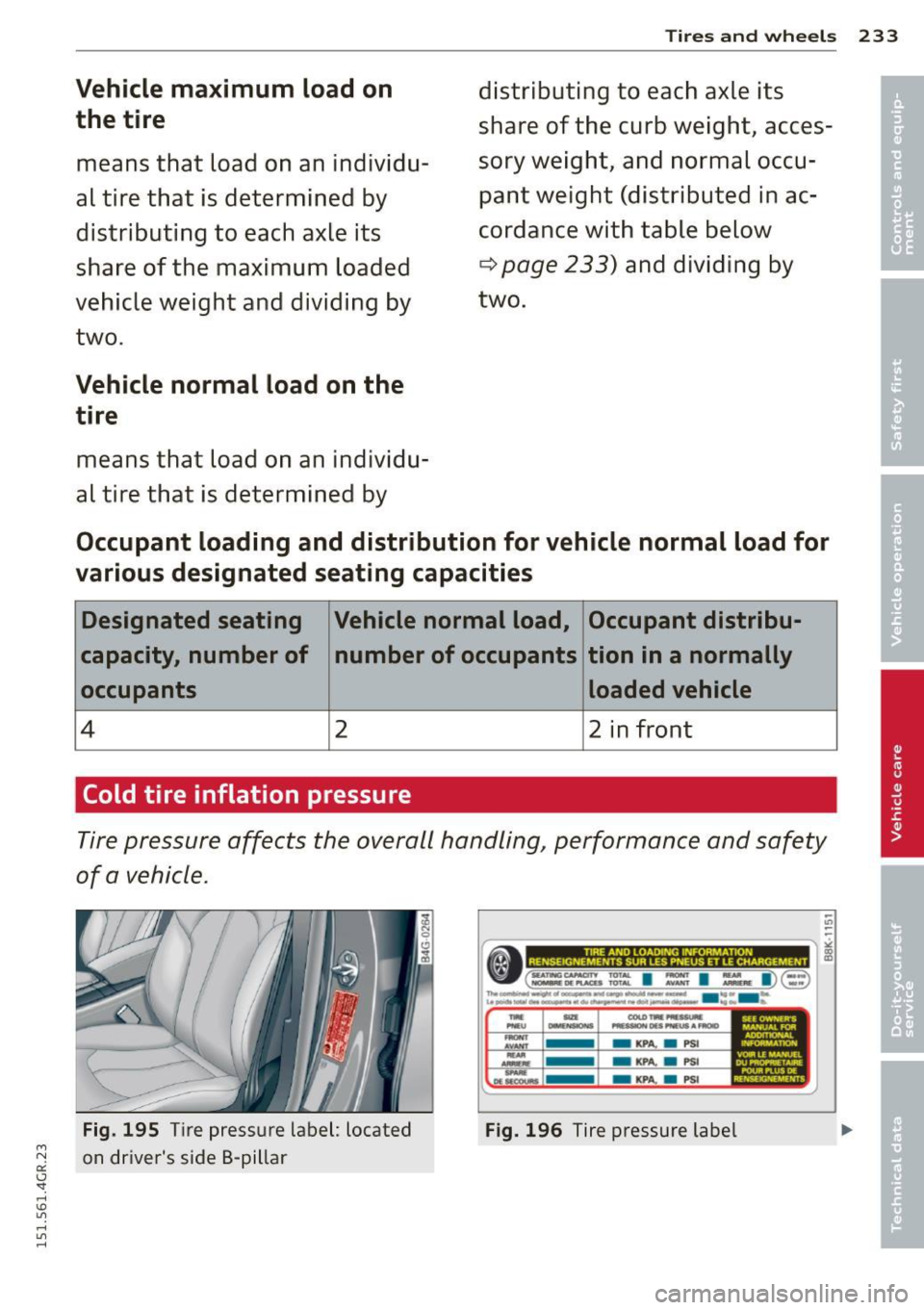
"' N
a:: I.J "". rl I.O
"' rl
"' rl
Vehicle maximum load on the tire
means that load on an individu
al tire that is determined by
distributing to each axle its
share of the maximum loaded
vehicle weight and dividing by two.
Vehicle normal load on the tire
means that load on an individu
al tire that is determined by
Tires and wheels 233
distributing to each axle its
share of the curb weight, acces
sory weight, and normal occu
pant weight (distributed in ac
cordance with table below
¢ page 233) and dividing by
two.
Occupant loading and distribution for vehicle normal load for
various designated seating capacities
Designated seating Vehicle normal load, Occupant distribu-
capacity, number of number of occupants tion in a normally
occupants loaded vehicle
4 2 2 in front
Cold tire inflation pressure
Tire pressure affects the overall
handlingJ performance and safety
of a vehicle.
Fig. 195 Tire pressure label: located
on driver's side B -pillar
-"' ---------------.... ,;,
& =-=====c=-=============== ::l
Ve=~= • = • =-1)§ -n,,......,..__.................................... • .... _ .. .................................... ___...,._ .. . -
- KPA, . PSI
- KPA. . PSI
- KPA. . PSI
Fig. 196 Tire pressure label
Page 236 of 302
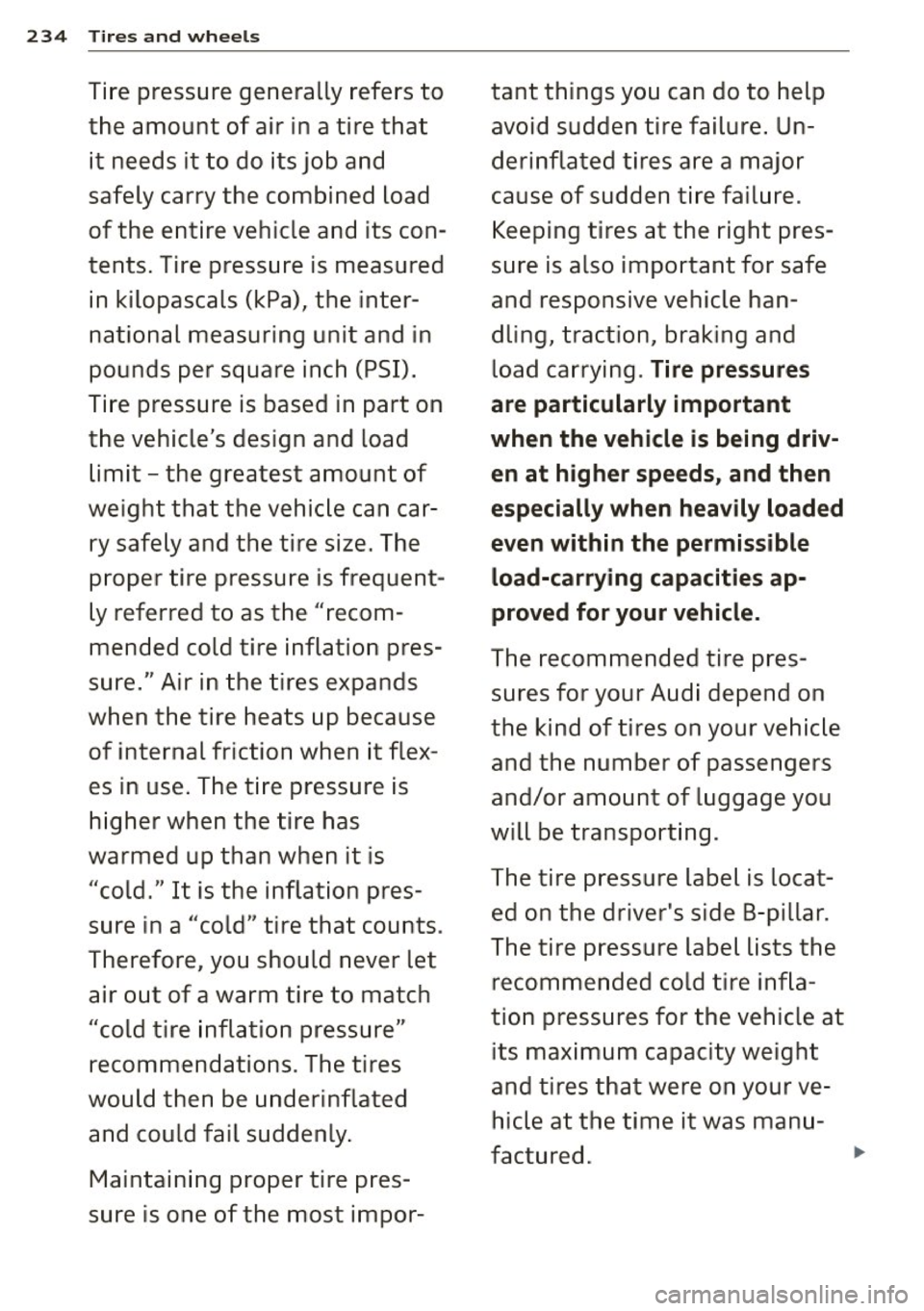
234 Tir es a nd whee ls
Ti re pressure generally refers to tant things you can do to help
the amount of a ir in a tire that avoid sudden tire failure . Un-
it needs it to do its job and derinflated tires are a major
safely carry the combined load cause of sudden ti re fa ilu re .
of the en tire vehicle and its con-
Keeping t ires at the right pres-
tents . Tire press ure is measured sure is also important for safe
i n ki lopascals (kPa), the inter- and responsive vehic le han-
national measuring unit and in dling , traction, braking and
pounds pe r square inch (PSI). load carryi ng .
Tire pressures
Ti re pressure is based in part on are particularly important
the vehicle's design and load when the vehicle is being driv-
lim it - the greatest amount of en at higher speeds, and then
weight that the vehicle can car -especially when heavily loaded
ry safely and the tire size. The even within the permissible
p rope r tire pressure is frequent -load-carrying capacities ap-
ly referred to as the " recom-proved for your vehicle.
mended cold tire inflation pres-
The recommended tire pres-
sure." Air in the tires expands
sures for your Audi depend on
when the tire heats up because the kind of tires on your vehicle
of internal friction when it flex-
and the number of passengers
es in use . The ti re pressure is
and/or amount of luggage you
h igher when the tire has
will be transpor ting.
warmed up than when it is The tire pressure labe l is locat-
"cold." It is the inflation p res-
ed on the driver's side 8 -pi llar .
sure in a "cold " tire that counts .
Therefore, you should never let The tire pressure label lists the
recommended cold t ire in fla-
air o ut of a warm tire to match
"cold tire inflation pressure" tion pressures for the vehicle at
its max imum capacity weight
recommendations . The tires
would t hen be underinflated and tires that were on your ve
-
a nd cou ld fai l suddenly . hicle at t
he time it was man u-
f actured .
...
Maintaining proper tire p res-
sure is one of the most impor-
Page 237 of 302
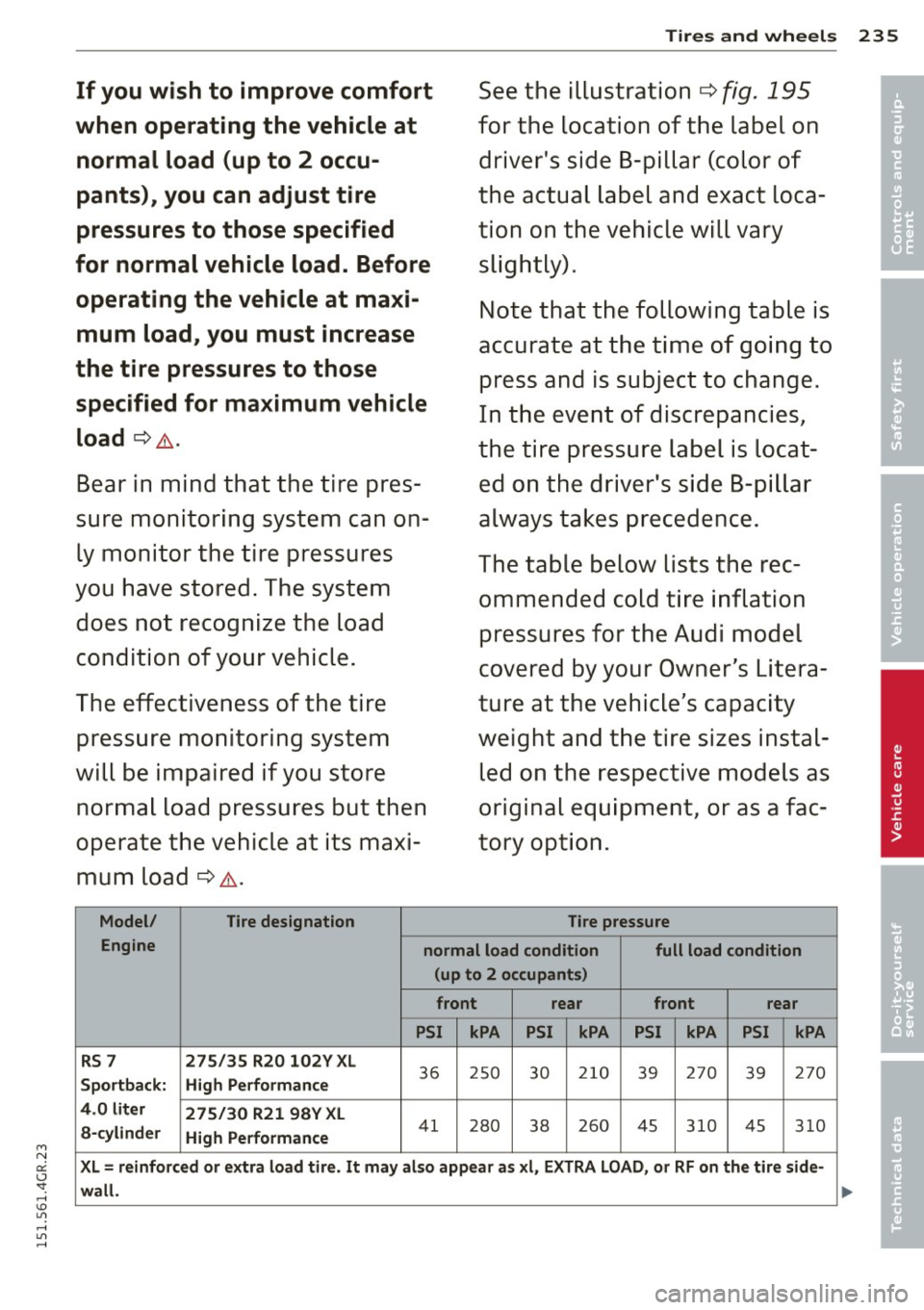
Tires and wheels 235
If you wish to improve comfort
when operating the vehicle at
normal load (up to 2 occu
pants), you can adjust tire
pressures to those specified
for normal vehicle load. Before
operating the vehicle at maxi mum load, you must increase
the tire pressures to those
specified for maximum vehicle
load
c> .&. .
Bear in mind that the tire pres
sure monitoring system can on
ly monitor the tire pressures
you have stored. The system does not recognize the load
condition of your vehicle.
The effectiveness of the tire p ressure monitoring system
will be impaired if you store normal load pressures but then
operate the vehicle at its maxi
mum load
c> .&. .
Model/ Tire designation
See the illustration c> fig. 195
for the location of the label on
driver's side B-pillar (color of
the actual label and exact loca
tion on the vehicle will vary slightly).
Note that the following table is
accurate at the time of going to
press and is subject to change.
In the event of discrepancies,
the tire pressure label is locat ed on the driver's side B-pillar
always takes precedence.
The table below lists the rec ommended cold tire inflation pressures for the Audi model
covered by your Owner's Litera
ture at the vehicle's capacity
weight and the tire sizes instal
led on the respective models as
original equipment , or as a fac
tory option.
Tire pressure
Engine normal load condition full load condition
(up to 2 occupants)
front rear front rear
PSI kPA PSI kPA PSI kPA PSI kPA
RS 7 275/35 R20 102V XL
3 6 250 30 210 39 270 39 270 Sportback: High Performance
4.0 liter 275/30 R21 98V XL
a -cylinder
High Performance
41 280 38 26
0 4 5 310 45 310
XL= reinforced or extra load tire. It may also appear as xl, EXTRA LOAD, or RF on the tire side-
wall.
•
•
'